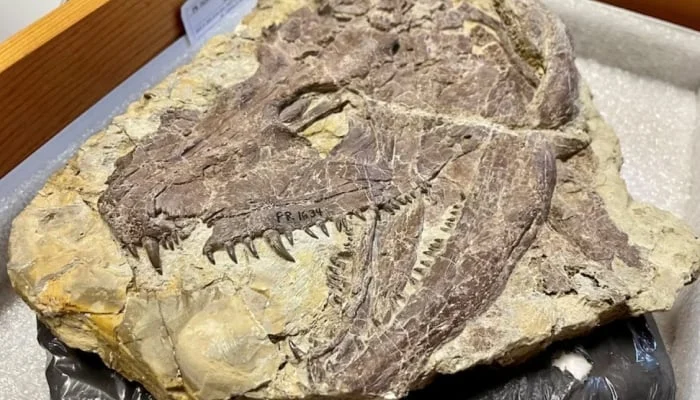In a captivating tale that spans decades, a fossil of remarkable significance has finally been identified by scientists after being inadvertently stumbled upon by an Australian chicken farmer back in the 1990s. The fossil, boasting distinctive features including tusks and intriguingly described as having “gnarly teeth,” has been determined to belong to a robust amphibian from 240 million years ago.
Uncovered by Mihail Mihailidis during routine tasks on his farm, the fossil emerged as he cleaned a sizeable sandstone slab initially intended as a garden retaining wall. Presented to the Australian Museum in 1997, this remarkably well-preserved specimen has been a source of fascination for researchers, who invested nearly three decades in piecing together the puzzle of its origins.
Palaeontologist Lachlan Hart from the University of New South Wales shared the revelation that had long eluded them: the amphibian in question was a “stout” creature measuring approximately 1.2 meters (almost four feet) from snout to tail. Its appearance, described as a fusion of a crocodile and a giant salamander, hinted at its role as a predator in its time.
The creature, dubbed “Arenaerpeton supinatus” in the scientific realm, belonged to the extinct group of animals known as “temnospondyls.” This amphibian, estimated to have existed before the era of dinosaurs, possessed unique adaptations that set it apart.
Hart detailed the amphibian’s probable hunting strategy, involving its distinct dental structure. He highlighted the presence of “quite gnarly teeth” along with fang-like tusks situated on the roof of its mouth. The rarity of finding specimens with both head and body intact, let alone preserved soft tissues, adds to the extraordinary nature of this discovery.
Utilizing an X-ray scanner typically employed for cargo inspection by Australia’s border force, researchers captured intricate details of the bulky fossil, offering insights into its anatomical features.
Initially found in the mid-1990s near the coastal town of Umina Beach, New South Wales, the discovery garnered global attention, prompting speculation about its potential implications for the narrative of human evolution. Australian Museum paleontologist Matthew McCurry underscored the fossil’s importance, designating it as one of the most significant discoveries in New South Wales over the past thirty years.
As scientists delve deeper into documenting this intriguing find, the fossil not only sheds light on the ancient past but also plays a crucial role in preserving Australia’s rich fossil heritage for generations to come.




